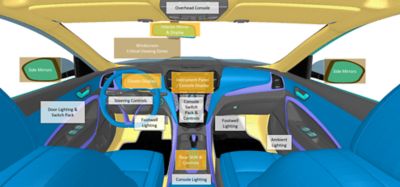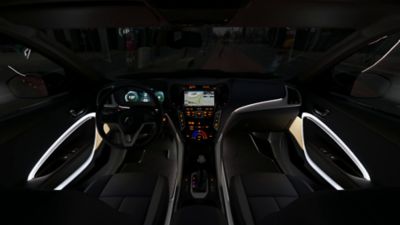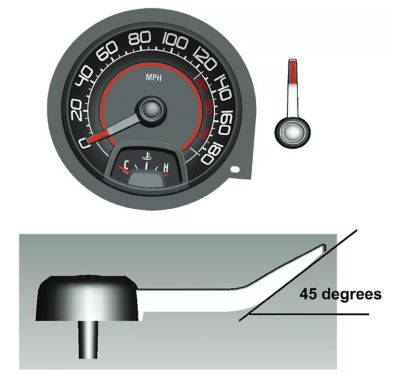ARGOMENTO IN DETTAGLIO
- Che cos'è l'illuminazione interna degli autoveicoli?
- Tipi di illuminazione interna degli autoveicoli
- Considerazioni sulla progettazione dell'illuminazione interna degli autoveicoli
- Affrontare le sfide di progettazione con Ansys Speos
- Tendenze future nell'illuminazione interna degli autoveicoli
- Affidarsi agli strumenti digitali per l'illuminazione degli interni nel settore automobilistico
Che cos'è l'illuminazione interna degli autoveicoli?
I veicoli sono dotati di molti tipi di sistemi di illuminazione interna ed esterna che svolgono una serie di funzioni, alcune riguardanti la sicurezza, altre lo stile. L'illuminazione all'interno di un veicolo è nota come illuminazione degli autoveicoli interna e include qualsiasi tipo di illuminazione interna che influisce sui conducenti e sui passeggeri, ma non ha alcun impatto su chiunque altro al di fuori del veicolo.
Le luci interne dell'auto possono visualizzare informazioni importanti, come la velocità e il livello di carburante o le varie spie di avviso che si illuminano quando c'è un problema (ad esempio un basso livello di olio o una temperatura elevata del motore). Le luci di cui stiamo parlando sono luci di sicurezza critiche e funzionali. Inoltre, si dispone di un'illuminazione elegante che migliora il comfort dei passeggeri, conferisce personalità all'auto e serve a scopi funzionali come l'illuminazione del pannello della portiera.
Con così tanti diversi sistemi di illuminazione interna all'interno di ogni veicolo, sono molte le sfide di progettazione ingegneristica da superare prima che un sistema di illuminazione sia adatto all'uso commerciale.
Tipi di illuminazione interna degli autoveicoli
I sistemi di illuminazione interna possono essere suddivisi in tre categorie principali, che contengono molti tipi diversi di singole luci interne:
- Illuminazione display
- Illuminazione
- Illuminazione ambientale (illuminazione d'accento)

Layout interno degli autoveicoli con esempi di fonti luminose comuni.
Illuminazione display
L'illuminazione del display trasmette informazioni al conducente e ai passeggeri, come velocità, navigazione e informazioni di sicurezza del motore. I sistemi di visualizzazione, come i touchscreen, si trovano anche nelle auto moderne al centro del cruscotto e vengono utilizzati per navigare nelle impostazioni della radio e del Bluetooth, controllare le app, coordinare l'aria condizionata e controllare altre funzioni atmosferiche dell'auto.
Alcuni esempi fondamentali di illuminazione del display includono:
- Illuminazione cruscotto
- Schermi multimediali
- Pannelli strumenti
- Navigazione satellitare
Tra le più recenti tecnologie di visualizzazione ci sono gli head-up display proiettati sul parabrezza e collegati al gruppo di componenti di illuminazione di sicurezza visualizzati appena sopra il volante. Spostare questi avvertimenti luminosi nel campo visivo del conducente significa che i conducenti non hanno bisogno di distogliere lo sguardo dalla strada per seguire la navigazione o vedere quali spie si sono accese.
Illuminazione
L'illuminazione è un'illuminazione funzionale all'interno dell'auto che aiuta le persone a vedere e trovare le cose all'interno del veicolo. L'illuminazione comunemente utilizzata all'interno dei veicoli include:
- Illuminazione plafoniera
- Illuminazione specchietti
- Illuminazione vano portaoggetti
- Illuminazione bagagliaio
- Luci lettura e mappa
- Illuminazione cassetto portaoggetti
- Luci di cortesia
Illuminazione ambientale
L'illuminazione ambientale, nota anche come illuminazione d'accento interna, viene utilizzata per fornire spunti di stile, creare un'atmosfera all'interno dell'auto e illuminare i diversi comandi nell'auto. L'illuminazione ambientale non è fondamentale per la funzionalità del veicolo e tende ad avere un'intensità luminosa inferiore perché non ha bisogno di illuminare altri oggetti all'interno del veicolo.
L'illuminazione ambientale è spesso posizionata sotto la linea della cintura di sicurezza del veicolo e mira a fornire un'esperienza utente migliore piuttosto che prestazioni di sicurezza o funzionali.
Alcuni esempi di applicazioni di illuminazione ambientale includono:
- Illuminazione di controllo dei finestrini
- Illuminazione attorno alle manopole della radio e ad altre manopole di controllo
- Illuminazione vano piedi
- Illuminazione pannello della portiera
- Illuminazione portabicchieri
- Illuminazione porte di ricarica
Considerazioni sulla progettazione dell'illuminazione interna degli autoveicoli

Illuminazione interna di un veicolo simulata nel software di simulazione ottica e di illuminazione integrata Ansys Speos CAD.
Con così tanti tipi diversi di luci interne per auto, ci sono molte considerazioni progettuali a cui gli ingegneri devono pensare dal punto di vista delle prestazioni e della sicurezza. Gli ingegneri devono anche considerare il consumatore che guiderà il veicolo, poiché lo stile è spesso valutato più della funzionalità. In molti casi, è necessario trovare un equilibrio tra funzionalità, stile e armonizzazione dei temi affinché tutte le parti siano soddisfatte del prodotto finale.

Il modello software Speos mostra in che modo il profilo e l'angolazione della lancetta del tachimetro si illuminano verso l'estremità della lancetta per consentire al conducente di vedere chiaramente la velocità alla quale sta guidando.
Piccoli componenti, come le lancette del tachimetro, sembrano molto semplici da progettare, ma dietro il loro aspetto semplicistico si nascondono strati di complessità.
Queste lancette vengono sottoposte a processi di incisione, rivestimento e verniciatura per ottenere la trasparenza ottica desiderata in modo che la luce possa attraversarle. Alcune contengono anche prismi sul retro della lancetta. Questi rivestimenti e vernici sono strati sottili, quindi è necessaria un'elevata precisione per progettare e produrre questi materiali.
Anche le altre piccole grafiche sul cruscotto richiedono che la plastica sia incisa fino alla trasparenza desiderata in modo che attraverso di esse la luce di diversi colori possa arrivare al conducente.
Scelta dei colori giusti
Oggi, gli ingegneri hanno a disposizione diverse opzioni LED e combinazioni di colori, per offrire più scelta al consumatore. Tuttavia, il rapporto costi/funzionalità di progettazione deve comunque essere mantenuto, poiché i sistemi di colore più stravaganti sono più costosi dei kit di illuminazione a LED tradizionali.
Le immagini sul cruscotto o sul quadro strumenti sono spie di sicurezza fondamentali per garantire che eventuali problemi vengano risolti immediatamente. Oggi, gli ingegneri hanno accesso a molti tipi di kit di illuminazione, quindi è possibile un maggiore grado di personalizzazione con i sistemi di illuminazione interna. Alcuni esempi di opzioni di illuminazione a disposizione degli ingegneri includono:
- Strisce LED
- Moduli LED
- Fibra ottica LED
- MicroLED
- LED bianchi
- LED multicolori/RGB
- Lampadine LED
- Lampadine convenzionali/a incandescenza
Poiché vengono utilizzati molti colori diversi, ad esempio, il rosso rappresenta una condizione di urgenza e richiede attenzione immediata, mentre l'arancione è meno urgente e richiede attenzione nel breve termine, questi colori devono essere uniformi e precisi, indipendentemente dal kit di illuminazione utilizzato.
Se i dati forniti dai sensori non sono accurati, il conducente potrebbe non essere in grado di individuare eventuali problemi che potrebbero compromettere la sicurezza del veicolo e delle persone a bordo. Una spia di "controllo motore" verde non comunica esattamente la stessa urgenza di quella rossa.
Progettazione dello spazio di packaging delle plafoniere
Un'altra considerazione per il design dell'illuminazione dell'abitacolo è incentrata su come ottimizzare lo spazio di packaging nelle plafoniere. Lo spazio di packaging è la prima cosa da considerare, in quanto deve essere accettabile dal punto di vista estetico per il conducente. Tuttavia, devono essere rispettati i requisiti relativi all'emissione luminosa in modo che ogni passeggero possa vedere all'interno dell'abitacolo quando la luce è accesa.
Le plafoniere sono una delle principali sfide di progettazione in cui deve esserci un compromesso tra stile e funzionalità. Il processo di progettazione richiede molto tempo tra ingegneria e stile per arrivare a un design vantaggioso da entrambi i punti di vista.
All'interno della lampada sono presenti i diversi componenti da considerare. Ad esempio, la lente potrebbe presentare venature o prismi per facilitare la propagazione e il puntamento della luce. La lente potrebbe anche richiedere un certo livello di trasparenza che deve essere progettato con precisione.
È inoltre necessario decidere quanti LED (o lampadine) verranno utilizzati nel progetto, poiché ciò influirà sui requisiti funzionali della lente e di altri componenti ottici della lampada.
Considerazioni sulla progettazione di LED singoli o multipli
Il passaggio da uno a due LED causa un notevole aumento dei costi ed è una decisione di progettazione che deve essere presa nelle fasi iniziali per tenere conto delle diverse considerazioni di progettazione. Un esempio pratico è dato dalle luci dei pannelli delle portiere. La curvatura e la lunghezza del tubo potrebbero richiedere più LED per ottenere un'emissione luminosa uniforme.
Allo stesso modo, il tipo di LED deve essere considerato tenendo presente costi e funzionalità, poiché alcuni LED offrono funzionalità ed effetti di luce multicolori. I LED RGB offrono maggiore flessibilità e libertà di personalizzare il colore del sistema di illuminazione, ma sono molto più costosi dei LED tradizionali. In alcuni casi, i tradizionali LED per interni devono essere scelti in base al volume del veicolo in produzione.
Affrontare le sfide di progettazione con Ansys Speos
L'ottimizzazione del processo di progettazione con software di simulazione come Ansys Speos aiuta a risparmiare tempo e denaro semplificando al tempo stesso il lavoro. Il software Speos è uno strumento di modellazione basato sulla fisica che prevede l'illuminazione e le prestazioni dei sistemi ottici, consentendo a progettisti e ingegneri di vedere le prestazioni dei sistemi ottici senza richiedere l'utilizzo di prototipi. Il software Speos può essere utilizzato dalla fase iniziale di fattibilità del concetto fino alle fasi di convalida.
Il software Speos considera i colori, i materiali e le potenziali posizioni di un sistema di illuminazione nelle prime fasi di progettazione per visualizzare come potrebbe apparire la luce e come potrebbe apparire il veicolo in tali condizioni di illuminazione, ben prima della sua realizzazione. Ciò consente ai progettisti e agli ingegneri di vedere il sistema nell'auto prima di prendere qualsiasi decisione importante. Una volta presa la decisione su dove andrà una luce o un sistema ottico, il software Speos può essere utilizzato per ottimizzare il progetto stesso, considerando lo spazio di packaging limitato, e facilitare progetti CAD più accurati basati su diverse configurazioni dei componenti, da una prospettiva optomeccanica.
Il software Speos può quindi essere utilizzato durante i cicli di sviluppo successivi per convalidare il comportamento, l'aspetto e l'armonizzazione del sistema di illuminazione con altri sistemi di illuminazione interna.
In questa fase, gli sviluppi includono tipicamente un sistema di illuminazione evoluto, che soddisfa tutti i requisiti elettrici, meccanici e ottici, valutato insieme a un abitacolo completamente modellato e alle condizioni di illuminazione ambientale (giorno, crepuscolo, notte): tutti questi scenari possono essere introdotti nei modelli software Speos per creare un ambiente di convalida coinvolgente.
Tendenze future nell'illuminazione interna degli autoveicoli
Emergono varie tendenze a breve e lungo termine che consentono di dare uno sguardo a come potrebbe essere il futuro dell'illuminazione interna delle automobili.
Luci di sicurezza per automobili a guida autonoma
L'illuminazione ambientale che fornisce informazioni sulla sicurezza ai conducenti sta diventando sempre più comune, soprattutto con l'avvento dei veicoli a guida autonoma e semi-autonoma.
Con il crescente interesse per i veicoli a guida autonoma, vengono sviluppati anche display avanzati per informare i conducenti di eventuali problemi di sicurezza tramite impulsi luminosi coordinati, come luci che lampeggiano o pulsano in un determinato colore (ad esempio in rosso) per avvisare il conducente di afferrare il volante se si sta per urtare un ciclista o ci si sta addormentando.
Vetri intelligenti
C'è anche un maggiore utilizzo di vetri intelligenti e di display a realtà aumentata, con coinvolgimento di componenti fotonici su scala nano-micro che proiettano su o all'interno di un parabrezza o altro componente di vetro. Questi si trovano negli head-up display o in altre aree dell'abitacolo del veicolo dove solitamente non vengono visualizzate informazioni, come i pannelli delle portiere o il cristallo del tettuccio apribile.
Molte concept car visualizzano informazioni in luoghi non tradizionali utilizzando vetri intelligenti, ma anche molti veicoli di produzione premium li utilizzano già oggi.
Materiali sostenibili
In definitiva, i sistemi di illuminazione diventeranno più efficienti e sostenibili attraverso l'uso di materiali nuovi o riciclati migliori per l'ambiente garantendo al tempo stesso che il sistema di illuminazione funzioni ancora in modo ottimale.
Affidarsi agli strumenti digitali per l'illuminazione degli interni nel settore automobilistico
L'illuminazione interna di un'auto è meno regolamentata rispetto all'illuminazione esterna, quindi i progettisti hanno a disposizione più opzioni di materiali per adattare i sistemi a ciascun veicolo.
Tuttavia, una maggiore scelta comporta anche maggiori difficoltà di progettazione, perché ci sono più potenziali combinazioni di opzioni di illuminazione che potrebbero teoricamente essere utilizzate.
Il processo di progettazione e validazione si basa su software di simulazione come Ansys Speos per determinare i migliori materiali e kit di illuminazione interna da utilizzare durante tutto il processo di progettazione. Il software Speos aiuta inoltre a bilanciare stile e funzionalità senza la necessità di costosi prototipi.
Scopri di più su come il software Speos può essere utilizzato per risolvere le tue sfide di progettazione dell'illuminazione interna in campo automobilistico contattando immediatamente il nostro team tecnico.










